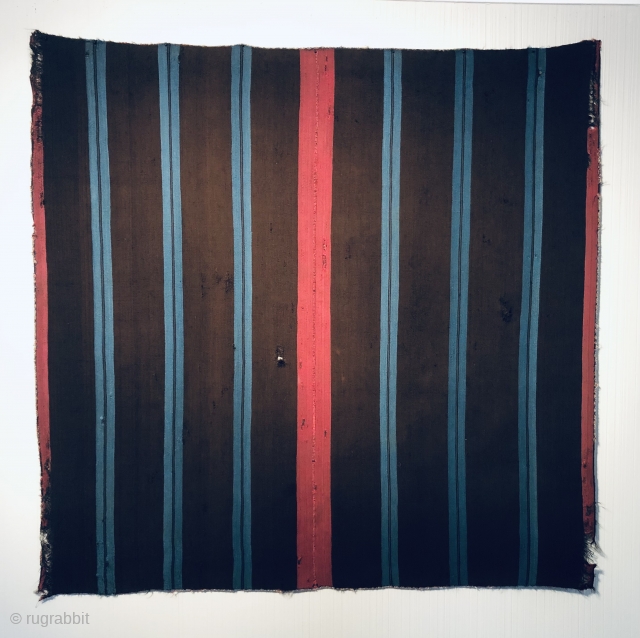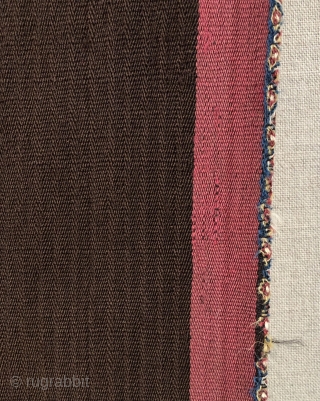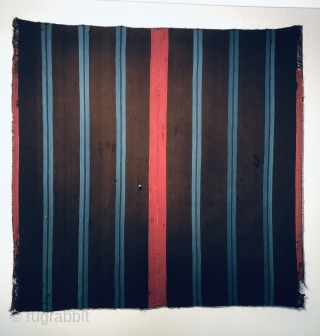Back
Rarely does one see such sublime and timeless beauty captured in a simple warp faced weaving. The fundamental and timeless design of simple warp striped textiles is epitomized in the pure, minimal form of this old wearing mantle. Even finer than the best of the beautiful warp faced weavings made by Shah Sevan weavers in the Near East, Aymara textiles remain unparalleled in the world of warp-faced weavings. The Aymara utilize a number of subtle techniques not found in weavings from any other culture. The detail of the warp striping near the edge of this textile is an example of using warps of alternate spin and ply in bands that result in the subtle herringbone-like patterns seen here in the dark brown ground. High altitude pastoralists, the Aymara of the Altiplano region of Bolivia, Peru and Chile mastered the skills of spinning, dying and weaving extraordinarily fine textiles using fiber from their herds of alpaca. Their animals were carefully bred over millennia for their lustrous, long staple fiber. The fineness and length of the alpaca fiber (hair not wool) allowed for spinning such fine yarns that the conquering Spaniards believed it finer than silk. The Aymara wove these textiles as ceremonial garments. They were passed down within the family for centuries. Based on the purity of the aesthetic and the fineness of its weave, this Iscayo or wearing mantle, could very well predate the 18th century and even possibly the 17th. Stored in humble stone or adobe dwellings at over 12,500 feet above sea level such pieces are a testament to the care and value the Aymara placed on their textiles. For them these were sacred representations of the ancestors. After the death of the original owner, such a piece would be passed down and used only a few times a year in ceremonies and rituals meant to honor deceased family members (ancestors). This practice has allowed some very rare examples to survive for as long as 500 years. Such things were curated and treasured without ever being buried for in some cases hundred of years. The result of this custom of preservation led to an exceedingly small number of textiles being far older than other ethnographic textiles from other world traditions. In rare instances, they can actually be “pre-Columbian” without ever having been interred with the dead in dry burials - as was the practice before the Spanish conquest of the Andean region in the early 16th century. The practice of keeping these textiles in sacred bundles in lieu of the body of the deceased ancestor began around the time the Spanish priests outlawed the pre-Columbian practice of interring the ancestors - dressed in fine textiles and placed in burial chambers - often dry caves. The descendants of the deceased ancestors would visit these caves and burial chambers periodically to meet with and care for the dead. They would symbolically feed and anoint them with alcoholic beverages and coca leaves while beseeching them to intercede with powers that be to grant favors that would enhance the fertility of the herds, improve the harvest or bring rain and prosperity to the community. When the Spanish priests discovered this practice they sought out and destroyed or burned the ancestral mummy bundles considering the practice to be a form of idolatry. It was at this time that the Aymara began to view the clothing of the deceased in a new way and the most precious pieces of cloth belonging to an ancestor now took the place of the body to become the actual embodiment of the ancestor. Since that time the practice of carefully maintaining bundles of ancestral cloth (Quepes) has persisted in only a very few areas. Such textiles would be removed from their bundles once or twice a year, donned by descendants and danced during festivals and ceremonies, thus reanimating the ancestors so that they could take part in these celebratory rituals. Because of this practice some very old Aymara textiles have managed to survive, often with serious damage - the result of days of drinking, chewing coca leaves, feasting and dancing. The Aymara seem to be the only indigenous group in the Andes to have maintained this tradition over the centuries and only a very few Aymara groups managed to keep these sacred bundles of ancestral cloth. Some of these bundles may contain as many as 10 or 12 textiles each - others less. Understandably, these bundles are exceedingly rare and usually restricted to areas that are quite remote and often highly traditional. Textiles that survive in this way can sometimes number no more than a single example of a particular style, coloration and design layout. Textiles like this rare example represent the last remnants of the longest continuous textile tradition in the Andes and demonstrate the supreme beauty of the ancient Aymara warp-faced textile tradition. 47 x 49 inches. Ex. Cathryn Cootner collection.
(*See Matt Polk and Amy Gould’s February, 2010 Textile Museum presentation using c14 analysis to date Aymara Textiles – published by r. John Howe @ https://rjohnhowe.wordpress.com/2010/05/23/carbon-dating-for-andean-text... – It is a wonderful view into these textiles with some of the greatest of the early Aymara textiles.)
price:
Inquire
- Home
- Antique Rugs by Region
- Category
- Profiles
- Post Items Free
- Albums
- Benaki Museum of Islamic Art
- Budapest: Ottoman Carpets
- Gulbenkian Museum
- Islamic Carpets. Brooklyn
- Islamic Textiles. Brooklyn
- Konya Museum: Rugs
- MKG, Hamburg
- MMA: Caucasian Carpets
- MMA: Mamluk Carpets
- MMA: Mughal Indian Carpets
- MMA: Ottoman Carpets
- MMA: Safavid Persian Carpets
- MMA: Turkmen Rugs
- McCoy Jones Kilims
- Ottoman textiles. Met
- Philadelphia Museum
- Rugs and Carpets: Berlin
- Seljuqs at the Met
- TIEM, Istanbul: Carpets
- V&A: Classical Carpets
- Vakiflar Carpets: Istanbul
- Baluch Rugs: Indianapolis
- Gallery Exhibitions
- Jaf an Exhibition
- Alberto Levi Gallery
- Andean Textile
- Christie's London: 2016
- Francesca Galloway
- HALI at 40
- ICOC Washington, DC 2018
- Jajims of the Shahsavan
- London Islamic Week April, 2018
- Mongolian Felts
- Navajo Rugs: JB Moore
- Persian Piled Weavings
- SF Tribal & Textile Art Show 2020
- SF Tribal 2019
- Sotheby's: C. Alexander
- Turkish Prayer Rugs
- Turkmen Main Carpets ICOC 2007












